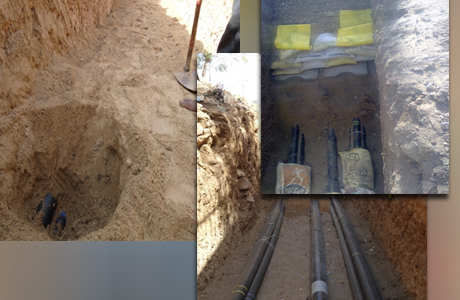- Determines the exact alignment of cable trench thus creating minimum interference to other agency’s installations.
- Helps to lay the cable without disturbing the existing utilities
- Able to maintain sufficient clearance between the cables & other utilities
- Should be straight
- Side walls should be free from sharp edges
- Walking bay along trench is necessary
- Curvature should be maintained (Normally 20D of cable)
- Rollers should be placed in 3 meters interval
- Curvature roller should be used in the corner of the trench
- Power rollers can be used if necessary
- Winch machine can be used.
- Power rollers can be used if necessary
- Cable drums will be lifted through spindle & jack arrangement
- Ramping arrangement should be made in front of cable drums to have smooth laying.
- Identification tape (R, Y, B) should be provided in each phase cable immediately after cable laying.
- Sufficient gap should be made if double circuit cable laid.
- Trefoil, Flat formation should be made as per requirement.
- Identification tape (R, Y, B) should be provided in each phase cable immediately after cable laying.
- Sufficient gap should be made if double circuit cable laid.
- Trefoil, Flat formation should be made as per requirement.
- River bed sand is used for sand filling.
- Most of cables are damaged by the human intervenes only.
- Such damages can be avoid by offering protective assets.
- RCC Slabs
- Caution Tapes
- Route Markers & Paintings
Protection of Cables (Cable end sealing)
- Route Marker & Paintings ( Suitable Route marker , Metal / RCC / Painting to be applied with Danger Sign on the entire route at appropriate distance.
- Should be compacted in layers with water shoring.













